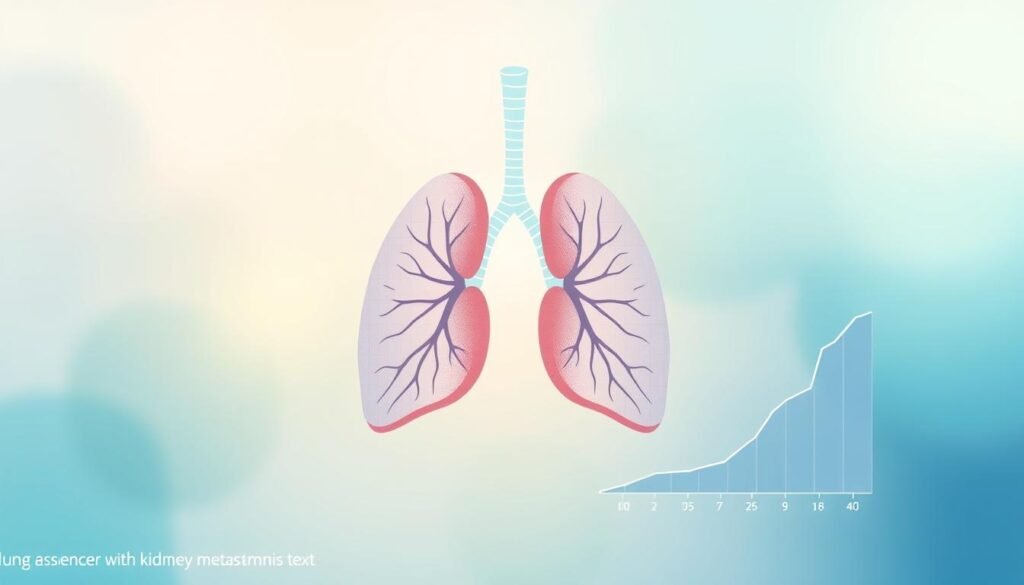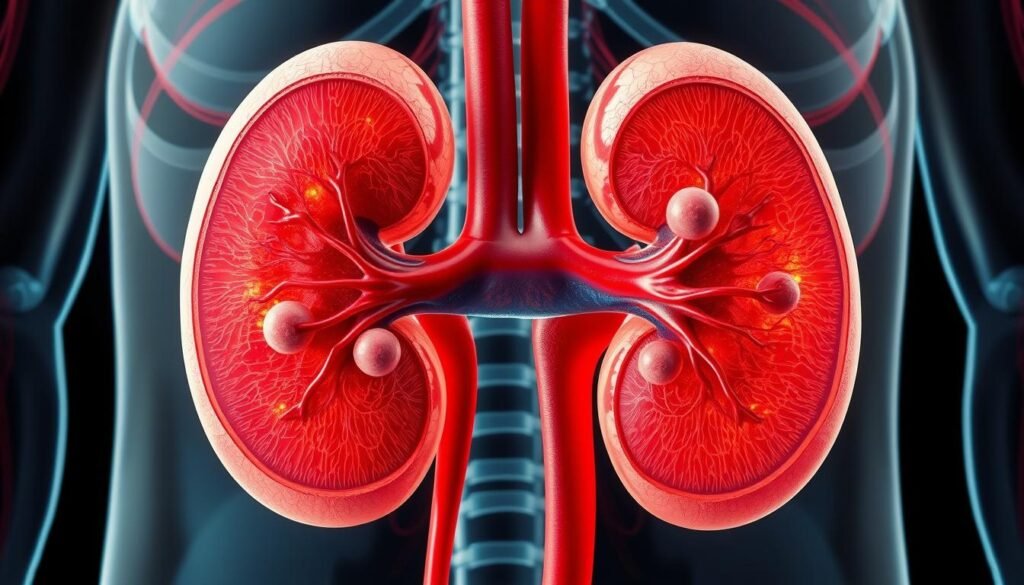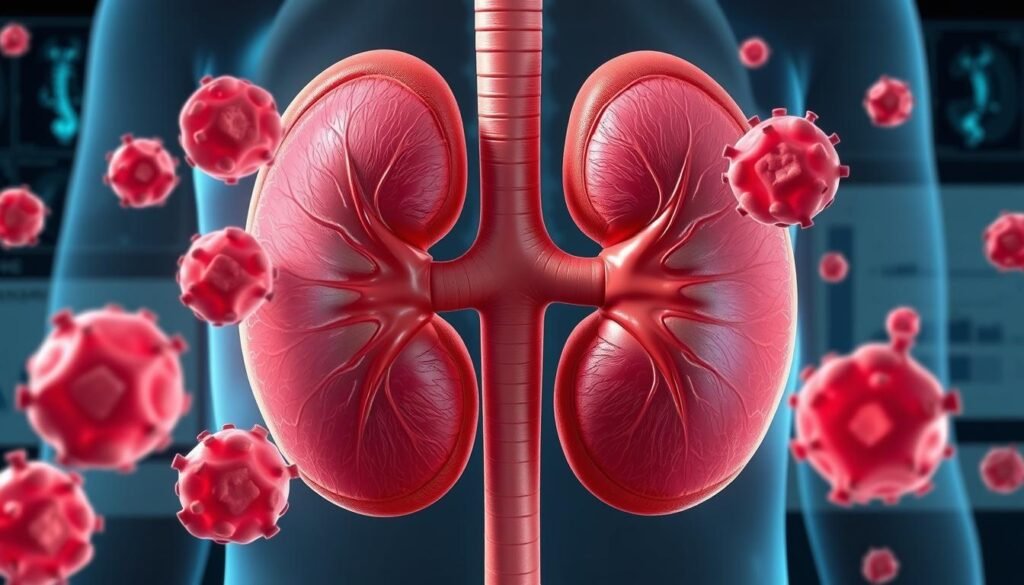Did you know that 25-30% of people with advanced lung cancer live less than three months? This fact shows the tough battle patients face when lung cancer spreads, including to the kidneys. Lung cancer is a top reason people die from cancer worldwide. Its spread poses great challenges.
When lung cancer spreads to the kidneys, it deeply affects life expectancy and health. Factors like the kind of lung cancer, overall health, and how well treatments work matter a lot. It’s vital for patients and their families to understand these issues.
Key Takeaways
- Lung cancer is a leading cause of cancer-related deaths worldwide.
- 25-30% of those with metastatic NSCLC may have life expectancies of under three months.
- The complexity of metastatic cancer impacts treatment options and prognosis.
- Awareness of kidney involvement is crucial in lung cancer treatment planning.
- Life expectancy with metastatic lung cancer in kidneys varies based on individual circumstances.
Understanding Lung Cancer and Its Metastasis
Lung cancer is a major health issue with cells growing uncontrollably in the lungs. This leads to tumor formation. There are various types of lung cancer which affect treatment and diagnosis. Knowing the types helps in figuring out treatment, especially when the cancer has spread.
What is Lung Cancer?
Lung cancer starts with abnormal cells in lung tissue growing out of control. This results in tumors that harm lung function. Factors like smoking, toxins, and genetics play a role. Spotting lung cancer early is key to better survival rates and treatments.
The Types of Lung Cancer: NSCLC and SCLC
Two main kinds of lung cancer exist: Non-Small Cell Lung Cancer (NSCLC) and Small Cell Lung Cancer (SCLC). NSCLC makes up about 85% of cases and is the most common. SCLC, though only 15% of cases, spreads fast. It’s crucial to know these types to treat the disease effectively.
Mechanism of Cancer Metastasis
Metastasis is when lung cancer cells move to other body parts, like the kidneys. The cancer cells invade nearby tissues and reach distant sites via blood or lymph systems. Understanding how metastasis works is vital. It helps in creating therapies that stop lung cancer from spreading, improving survival.
https://www.youtube.com/watch?v=ihCnDjyJv5c
Statistics on Lung Cancer Survival Rates
Lung cancer stats offer insight into what patients might expect, especially with kidney metastases. The five-year survival rate for lung cancer is under 20%. This low number shows how hard it is to treat and find lung cancer early, especially after it spreads.
Overall Survival Rates for Lung Cancer
Survival rates for lung cancer change a lot based on different things. This includes the stage when diagnosed. For example, localized non-small-cell lung cancer (NSCLC) survival is about 60%. But, for patients whose cancer has spread to places like the kidneys, the rate falls to around 6%.
For small-cell lung cancer (SCLC), the outlook is worse, with a survival rate of just 6% for all stages. Distant SCLC survival is even lower at 3%. These figures show how severe lung cancer can be, especially when it moves to other parts of the body.
Factors Influencing Survival Rates
Many factors affect lung cancer survival rates when the cancer has spread to the kidneys. Age matters; younger people often do better than older ones. Race and general health also make a big difference in outcomes. How far the cancer has spread is another key factor. Early-stage diagnosis, where cancer hasn’t spread much, offers better survival chances.
Nowadays, new treatments for lung cancer are being studied. Over 1,500 clinical trials are underway to find better therapies. For more information on lung cancer metastasis and treatment, check this resource.

Lung Cancer Spread to Kidneys Life Expectancy
When lung cancer spreads to the kidneys, the prognosis becomes worrisome. It’s crucial to grasp the impact on life expectancy this expansion implies. This awareness is key in understanding the severity of the condition.
Life Expectancy Overview with Kidney Involvement
Metastatic lung cancer that reaches the kidneys has a five-year survival rate of about 7%. This decline in survival rate is quite shocking. It highlights the fierce nature of small cell lung cancer (SCLC), making up 10 to 15 percent of cases.
On the other hand, non-small cell lung cancer (NSCLC) is more common, covering 85 percent of cases. In NSCLC, adenocarcinomas are most frequently seen. Squamous cell carcinoma and large cell carcinoma follow, affecting the prognosis of kidney metastases from lung cancer.
Case Studies and Clinical Findings
Studies show the time from lung cancer diagnosis to kidney impact is often brief. The survival rates for metastatic NSCLC are around 6%. SCLC cases see even lower survival rates, dropping to 3%.
Survival times for stage 4 lung cancer vary from 6.3 to 11.4 months. This stresses the fast progression of the disease. Quitting smoking before chemotherapy can extend life expectancy by six months. Yet, diseases like congestive heart failure deeply affect survival.

Identifying Kidney Metastases from Lung Cancer
Knowing the symptoms of renal metastases is key to catching it early. Signs include back pain and blood in urine. However, some patients don’t show symptoms until tested. Quick action after spotting these signs is vital to improve treatment success.
Symptoms and Diagnosis of Renal Metastases
Doctors diagnose kidney metastases from lung cancer by looking at symptoms and test results. They use clinical exams and imaging to spot metastases. Pain and blood in urine, along with imaging, help confirm the diagnosis.
A study shows the value of precise imaging in lung cancer cases. It helps tell if kidney masses are metastatic or primary tumors. Biopsies then confirm metastases and check for other cancers.
Good imaging leads to fast treatment, improving chances for patients.
Imaging Techniques Used in Diagnosis
Imaging is crucial for spotting renal metastases. CT scans are a major tool for showing kidney tumors. They differentiate between metastatic and primary kidney cancers, guiding treatment choices.
High-tech imaging gives doctors key info to diagnose. It helps understand the metastasis’ spread, especially from lung cancer. Mixing imaging with patient data ensures a strong diagnosis.

Prognosis of Metastatic Lung Cancer to Kidneys
When lung cancer spreads to the kidneys, it worsens the outlook for patients. Those with this condition often see their survival chances drop. Understanding this can help improve care for these patients.
Impact on Overall Survival Rates
Moving to metastatic kidney cancer, the 5-year survival rate is only 17%. This is low compared to a 93% rate for localized cases. Regional cancers, with a 74% rate, also do better than when cancer has spread far.
The stages of cancer show big differences in patient outcomes. Factors like where cancer spreads, including bones and liver, affect survival rates. Each patient’s situation is unique, based on their health and cancer type. The Cancer.org database offers more details on this.
Understanding Multi-Site Metastases
Dealing with cancer that has spread to multiple sites, like kidneys, is tough. When lung cancer reaches stage 4, it can also affect adrenal glands and distant nodes. For example, renal cell carcinoma in the lungs can cut survival rates to nearly zero without treatment.
This situation poses a big challenge for healthcare providers. They must think about tumor size, lymph node involvement, and patient health. Grasping these details is crucial for targeted care, especially with kidney-involved lung cancer.
| Stage | 5-Year Survival Rate | Key Characteristics |
|---|---|---|
| Localized | 93% | Confined to the kidney |
| Regional | 74% | Spread to nearby structures |
| Metastatic | 17% | Spread to distant sites |
| Overall (All Stages) | 77.6% | Combined data across all stages |
Treatment Options for Lung Cancer That Has Spread to Kidneys
When lung cancer spreads to the kidneys, the focus is on treating both cancers. Doctors look at different medical treatments before suggesting surgery for lung cancer. Learning about these options is vital for patients.
Medical Treatment Approaches
Medical treatments mainly use systemic therapies for lung cancer in the kidneys. Depending on the cancer type and stage, chemotherapy and targeted therapies are options. While chemotherapy is a go-to, targeted therapy could be a choice based on genetic markers and tumor details.
Immunotherapy is considered for those with advanced disease. It boosts the immune system to fight cancer. This can help extend life and enhance life quality. Treatments are customized for each patient, looking at health and past treatments. See this study on chronic kidney disease for more information.
Surgical Interventions and Their Effectiveness
If kidney metastases are single, surgery might be an option. This could involve nephrectomy, or removing the kidney, to get rid of cancer. But surgery success depends on how far the disease has spread and the patient’s health.
Surgery could improve survival if the cancer is caught early and there are no other health issues. Other surgical options, like partial nephrectomy or ablative therapies, might be chosen based on the tumor’s size and stage. Combining surgery with medical treatments often works best for lung cancer that has reached the kidneys.
Palliative Care for Metastatic Lung Cancer in Kidneys
Palliative care is crucial for patients with metastatic lung cancer, especially when it affects the kidneys. It helps manage symptoms and addresses emotional, physical, and psychological issues. This type of care makes a huge difference in improving patient well-being while reducing discomfort.
Importance of Palliative Care
Palliative care for metastatic lung cancer in kidneys aims to boost life quality. It focuses on easing symptoms rather than curing the disease. It helps those in pain, feeling tired, or distressed through a team-based approach.
Managing Symptoms and Enhancing Quality of Life
Managing symptoms well is key for those with metastatic lung cancer in kidneys. Pain, nausea, and tiredness are common issues. Care plans often include:
- Pain Control: Medications and therapies are used to ease pain.
- Nutritional Support: Proper diet boosts strength and energy.
- Psychological Support: Counseling and groups aid emotional health.
- Holistic Approaches: Techniques like acupuncture improve relaxation and wellness.
| Symptom | Management Strategies |
|---|---|
| Pain | Analgesics, physical therapy, relaxation techniques |
| Nausea | Anti-emetic medications, dietary adjustments |
| Fatigue | Rest, nutrition, gentle activities |
| Emotional Distress | Counseling, support groups, mindfulness practices |
In conclusion, the goal of palliative care for metastatic lung cancer in kidneys is symptom management. This focuses on improving quality of life and building resilience.
Quality of Life with Advanced Lung Cancer and Kidney Metastases
Living with advanced lung cancer and kidney metastases deeply affects life quality. Emotional struggles often outshine physical problems. Understanding these issues is vital for those affected and their loved ones. While treatments can help with symptoms, emotional support is equally important.
Emotional and Psychological Effects
Patients experience a range of emotions, from anxiety and depression to feeling alone. Just hearing the diagnosis can be very stressful. To cope, some find help in therapy, mindfulness, and support groups. Being active in these groups can help manage stress and build strength.
Support Systems for Patients and Families
Support systems are crucial for people facing advanced lung cancer with kidney metastases. Families and caregivers offer much-needed emotional and physical support. Professional help like counseling and palliative care improves life for these patients. Many groups provide aid for patients and their families, helping them handle the disease’s emotional and practical sides. A strong support network reduces stress and brings hope.
| Emotional Effect | Support Strategies |
|---|---|
| Anxiety | Mindfulness, therapy |
| Depression | Support groups, professional counseling |
| Isolation | Family support, social engagement |
| Stress | Relaxation techniques, palliative care |
To manage the emotional impact of advanced lung cancer, a comprehensive approach is needed. This approach should mix medical treatment with emotional support. Through therapy and connections, patients can find some ease on their journey.
For more insights into survival rates and living quality, visit this link for information on lung cancer life expectancy.
Conclusion
The path through lung cancer spreading to the kidneys is complex. It affects the patient’s life expectancy and treatment options greatly. NSCLC makes up 80% to 85% of lung cancer cases and poses unique treatment challenges compared to SCLC. A shocking fact shows that about 53% of lung cancer patients already have metastasis at diagnosis.
Discussing treatments for kidney metastases highlights the need for personalized care. This includes various medical treatments, surgical options, and palliative care. The goal is to improve life’s length and quality. Careful planning and teamwork are key for a supportive discussion about the patient’s future and treatment.
Tackling lung cancer’s spread to the kidneys needs a full understanding and teamwork among medical professionals, patients, and their families. Open communication and using all available treatments help patients face this tough journey. This approach brings hope and a chance for a better life quality.